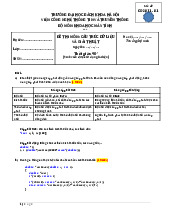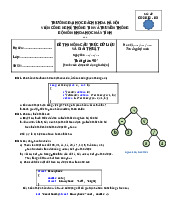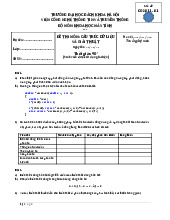



















Preview text:
lOMoAR cPSD| 27879799 Sorting ❑ Bubble sort ❑ Insertion sort ❑ Selection sort ❑ Heap sort ❑ Merge sort ❑ Quicksort 1
ET210x: Data Structures & Algorithms
Đo Trung KiŒn @ MICA Institute & Dept. of Comm. Eng., SEEE, Hanoi Univ. of Science and Technology 1 Overview Arranging data in a certain order Purposes: Visualization Searching Strategies to sort data Let s imagine how we arrange cards or documents in order
How to judge the efficiency of a sorting algorithm? Time taken Memory used
Data stored in an array or a linked list 2
ET210x: Data Structures & Algorithms
Đo Trung KiŒn @ MICA Institute & Dept. of Comm. Eng., SEEE, Hanoi Univ. of Science and Technology lOMoAR cPSD| 27879799 2 Bubble sort 3
ET210x: Data Structures & Algorithms
Đo Trung KiŒn @ MICA Institute & Dept. of Comm. Eng., SEEE, Hanoi Univ. of Science and Technology 3 Overview Principle
Bigger elements bubble toward the end of the list 4 4
ET210x: Data Structures & Algorithms
Đo Trung KiŒn @ MICA Institute & Dept. of Comm. Eng., SEEE, Hanoi Univ. of Science and Technology lOMoAR cPSD| 27879799 Algorithm Repeat until the array is sorted:This is Step through the first arrayiteration Compare each pair of adjacent itemsDo similarly
Swap them if for next they are in the iterations wrong orderuntil the array is sorted 5
Đo Trung KiŒn @ MICA Institute & Dept. of Comm. Eng., SEEE, Hanoi Univ. of Science and TechnologyET210x: Data Structures & Algorithms 5
Na ve version (without termination checking)
void sortBubbleSimple(int* a, int n)
{ int i, j; for (i = n; i > 0; i-
-) { for (j = 0; j < i - 1; j++)
{ if (a[j] > a[j + 1]) swap(a, j, j + 1); } }
ET210x: Data Structures & Algorithms
Đo Trung KiŒn @ MICA Institute & Dept. of Comm. Eng., SEEE, Hanoi Univ. of Science and Technology lOMoAR cPSD| 27879799 } 6 6 With termination checking
void sortBubbleImproved(int* a, int n)
{ int i, j, sorted = 0; for (i =
n; !sorted && i > 0; i--) { sorted =
1; for (j = 0; j < i - 1; j++) { if
(a[j] > a[j + 1]) { swap(a, j, j + 1); sorted = 0; } } } } 7
Đo Trung KiŒn @ MICA Institute & Dept. of Comm. Eng., SEEE, Hanoi Univ. of Science and TechnologyET210x: Data Structures & Algorithms 7 Complexity Computation:
Worst case: when array is in reversed order Number of
comparisons = no. of swaps = 𝑛 𝑛 1 /2 Complexity: O(𝑛 ) Average case: O(𝑛 )
Best case: when the array is already sorted
O(𝑛 ) for simple algorithm O(𝑛) for improved algorithm Memory consumption: O(1)
Generally not suitable in real applications Good use cases
ET210x: Data Structures & Algorithms
Đo Trung KiŒn @ MICA Institute & Dept. of Comm. Eng., SEEE, Hanoi Univ. of Science and Technology lOMoAR cPSD| 27879799 Data is almost sorted
Number of elements is small
Can be implemented recursively 8 8 Insertion sort 9
ET210x: Data Structures & Algorithms
Đo Trung KiŒn @ MICA Institute & Dept. of Comm. Eng., SEEE, Hanoi Univ. of Science and Technology 9 Overview Principle: Like sorting a hand of cards Pick cards one by one Each time, insert a card in the right place among the sorted cards 10
ET210x: Data Structures & Algorithms
Đo Trung KiŒn @ MICA Institute & Dept. of Comm. Eng., SEEE, Hanoi Univ. of Science and Technology lOMoAR cPSD| 27879799 10 Algorithm
Go through the array from left to right:
Pick the first element in the unsorted part (right part)
Find the right place for that element in the
sorted part (left part)
Move (insert) the element to the found place
Expand the sorted part by 1 element, and shrink the unsorted part
Attn: After the 𝑖th iteration, the 𝑖 left most elements are sorted part 11
ET210x: Data Structures & Algorithms
Đ oTrung KiŒn@ MICA Institute & Dept. of Comm. Eng., SEEE, Hanoi Univ. of Science and Technology 11 Simple version
void sortInsertionSimple(int* a, int n)
{ int i, j; for (i = 1; i < n; i++) {
for (j = i; j>0 && a[j]-) swap(a, j, j-1); } }
ET210x: Data Structures & Algorithms
Đo Trung KiŒn @ MICA Institute & Dept. of Comm. Eng., SEEE, Hanoi Univ. of Science and Technology lOMoAR cPSD| 27879799 12 12 Better version
void sortInsertionImproved(int* a, int n)
{ int i, j, t; for (i = 1; i < n; i++) { t = a[i];
for (j = i; j>0 && t a[j] = a[j-1]; a[j] = t; 13
Đo Trung KiŒn @ MICA Institute & Dept. of Comm. Eng., SEEE, Hanoi Univ. of Science and TechnologyET210x: Data Structures & Algorithms 13 Complexity Computation:
Worst case: when array is in reversed order
Number of comparisons = no. of moves = 𝑛 𝑛 1 /2 Complexity: O(𝑛 ) Average case: O(𝑛 )
Best case: when the array is already sorted
O(𝑛 ) for simple algorithm O(𝑛) for improved algorithm Memory consumption: O(1)
ET210x: Data Structures & Algorithms
Đo Trung KiŒn @ MICA Institute & Dept. of Comm. Eng., SEEE, Hanoi Univ. of Science and Technology lOMoAR cPSD| 27879799
Can be implemented recursively 14 14 Selection sort 15
ET210x: Data Structures & Algorithms
Đo Trung KiŒn @ MICA Institute & Dept. of Comm. Eng., SEEE, Hanoi Univ. of Science and Technology 15 Overview
For insertion sort, we pick the element first, then find the place to put it
For selection sort, we do in the reverse way: find the
place first, then find the element to put there 16 16
ET210x: Data Structures & Algorithms
Đo Trung KiŒn @ MICA Institute & Dept. of Comm. Eng., SEEE, Hanoi Univ. of Science and Technology lOMoAR cPSD| 27879799 Algorithm
Go from left to right of the array
Pick the smallest element from the unsorted part
Swap it with the first element in the unsorted part
Expand the sorted part by one
Attn: After the 𝑖th iteration, the 𝑖 left most elements are sorted part
17 Đo Trung KiŒn @ MICA Institute & Dept. of Comm. Eng., SEEE, Hanoi Univ. of
Science and TechnologyET210x: Data Structures & Algorithms 17 Implementation
void sortSelectionSimple(int* a, int n)
{ int i, j; for (i = 0; i < n-1; i++)
{ for (j = i+1; j < n; j++) { if
(a[i] > a[j]) swap(a, i, j); } } } 18 18
ET210x: Data Structures & Algorithms
Đo Trung KiŒn @ MICA Institute & Dept. of Comm. Eng., SEEE, Hanoi Univ. of Science and Technology lOMoAR cPSD| 27879799 Implementation
void sortSelectionImproved(int* a, int n)
{ int i, j, mi; for (i = 0; i < n-1;
i++) { for (mi = i, j = i+1; j < n;
j++) { if (a[j] < a[mi]) mi = j; } if (mi != i) swap(a, i, mi); } } 19
Đo Trung KiŒn @ MICA Institute & Dept. of Comm. Eng., SEEE, Hanoi Univ. of Science and TechnologyET210x: Data Structures & Algorithms 19 Complexity Computation:
Worst case: when array is in reversed order
Number of comparisons: 𝑛 𝑛 1 /2 Number of swaps: 𝑛 Complexity: O(𝑛 ) Average case: O(𝑛 )
Best case: O(𝑛 ) when the array is already sorted Memory consumption: O(1)
Can be implemented recursively 20
ET210x: Data Structures & Algorithms
Đo Trung KiŒn @ MICA Institute & Dept. of Comm. Eng., SEEE, Hanoi Univ. of Science and Technology lOMoAR cPSD| 27879799 20 Heap sort 21
ET210x: Data Structures & Algorithms
Đo Trung KiŒn @ MICA Institute & Dept. of Comm. Eng., SEEE, Hanoi Univ. of Science and Technology 21 Overview
Based on a binary heap that helps to easily find the max (or min) elements Similar principle to selection sort, but the way to find the max elements is different Binary heap: A complete binary tree Two types: min heap, max heap No additional tree is needed since the tree is maintained by the array itself 22 22 Algorithm
Build a binary max heap Repeat until the array is sorted:
ET210x: Data Structures & Algorithms
Đo Trung KiŒn @ MICA Institute & Dept. of Comm. Eng., SEEE, Hanoi Univ. of Science and Technology lOMoAR cPSD| 27879799
Swap the max (first) and the last elements in the array Reduce the data size by 1
Correct the heap because of the root node s new value Attn:
In a max heap, the root element has the max value
The first element in the array corresponds to the root in the tree 23
Đo Trung KiŒn @ MICA Institute & Dept. of Comm. Eng., SEEE, Hanoi Univ. of Science and TechnologyET210x: Data Structures & Algorithms 23 Building max heap
For each node, make sure that its children are smaller
Check from lower nodes up to the root
No need to check leaf nodes ➔ Only check the first 𝑛 /2 Leaf nodes elements in the array 24 24
ET210x: Data Structures & Algorithms
Đo Trung KiŒn @ MICA Institute & Dept. of Comm. Eng., SEEE, Hanoi Univ. of Science and Technology lOMoAR cPSD| 27879799 Example: Max heap
1 4 3 7 8 9 10
1 4 10 7 8 9 3
1 8 10 7 4 9 3
10 8 1 7 4 9 3 1
8 9 7 4 1 3 25
Đo Trung KiŒn @ MICA Institute & Dept. of Comm. Eng., SEEE, Hanoi Univ. of Science and TechnologyET210x: Data Structures & Algorithms 25 Example: Heap sort Step 1: Max heap Step 2: Arrange Step 3: Max heap
8 4 7 1 3 5
5 4 7 1 3 8
7 4 5 1 3 8
ET210x: Data Structures & Algorithms
Đo Trung KiŒn @ MICA Institute & Dept. of Comm. Eng., SEEE, Hanoi Univ. of Science and Technology lOMoAR cPSD| 27879799 26 26
Example: Heap sort (cont d) Step 4: Arrange Step 5: Max heap Step 6: Arrange
3 4 5 1 7 8
5 4 3 1 7 8
1 4 3 5 7 8 27
Đo Trung KiŒn @ MICA Institute & Dept. of Comm. Eng., SEEE, Hanoi Univ. of Science and TechnologyET210x: Data Structures & Algorithms 27
Example: Heap sort (cont d) Step 7: Max heap Step 8: Arrange
4 1 3 5 7 8
3 1 4 5 7 8
ET210x: Data Structures & Algorithms
Đo Trung KiŒn @ MICA Institute & Dept. of Comm. Eng., SEEE, Hanoi Univ. of Science and Technology lOMoAR cPSD| 27879799 28 28
Example: Heap sort (cont d) Step 9: Max heap Step 10: Arrange
3 1 4 5 7 8
1 3 4 5 7 8 29
Đo Trung KiŒn @ MICA Institute & Dept. of Comm. Eng., SEEE, Hanoi Univ. of Science and TechnologyET210x: Data Structures & Algorithms 29
Implementation: Correct heap node
void correctHeapNode(int* a, int n, int i)
{ int l = i*2 + 1, r = l + 1, m = i; if
(l < n && a[l] > a[m]) m = l; if (r < n
&& a[r] > a[m]) m = r; if (m != i) { swap(a, i, m); correctHeapNode(a, n, m); } }
ET210x: Data Structures & Algorithms
Đo Trung KiŒn @ MICA Institute & Dept. of Comm. Eng., SEEE, Hanoi Univ. of Science and Technology lOMoAR cPSD| 27879799 30 30 Implementation: Max heap void buildHeap(int* a, int n)
{ for (int i = n/2; i >= 0; i- -) correctHeapNode(a, n, i); } 31
Đo Trung KiŒn @ MICA Institute & Dept. of Comm. Eng., SEEE, Hanoi Univ. of Science and TechnologyET210x: Data Structures & Algorithms 31 Implementation: Heap sort void sortHeap(int* a, int n) { buildHeap(a, n);
for (int i = n; i > 1; i--) { swap(a, 0, i-1); correctHeapNode(a, i-1, 0); } }
ET210x: Data Structures & Algorithms
Đo Trung KiŒn @ MICA Institute & Dept. of Comm. Eng., SEEE, Hanoi Univ. of Science and Technology lOMoAR cPSD| 27879799 32 32 Complexity Computation Correct node: O(log𝑛)
Build heap: O(𝑛log𝑛) Main loop: O(𝑛log𝑛) Overal : O(𝑛log𝑛) Memory (stack) Correct node: O(log𝑛) Build heap: O(log𝑛) Main loop: O(log𝑛) Overal : O(log𝑛) 33
Đo Trung KiŒn @ MICA Institute & Dept. of Comm. Eng., SEEE, Hanoi Univ. of Science and TechnologyET210x: Data Structures & Algorithms 33 Merge sort 34 34
ET210x: Data Structures & Algorithms
Đo Trung KiŒn @ MICA Institute & Dept. of Comm. Eng., SEEE, Hanoi Univ. of Science and Technology lOMoAR cPSD| 27879799 Overview Initial idea:
Bubble, insertion, selection sorts all have complexity of O(𝑛 )
➔ The computational time grows quickly when 𝑛 is large
➔ Subdivide the problem into smaller tasks
Divide and conquer approach (recursive implementation) Divide into two parts Sort each parts separately Merge the two sorted parts 35
Đo Trung KiŒn @ MICA Institute & Dept. of Comm. Eng., SEEE, Hanoi Univ. of Science and TechnologyET210x: Data Structures & Algorithms 35
ET210x: Data Structures & Algorithms
Đo Trung KiŒn @ MICA Institute & Dept. of Comm. Eng., SEEE, Hanoi Univ. of Science and Technology lOMoAR cPSD| 27879799 Algorithm Based on two operations: Division Divide continuously until the arrays become elementary (with 1 item) Merging Combine two sorted arrays 36 36 Implementation
void sortMergePart(int* a, int l, int r) { int
m = (l + r)/2; if (m > l) sortMergePart(a,
l, m); if (m + 1 < r) sortMergePart(a, m +
1, r); mergePartsXXX(a, l, m, r); } void sortMerge(int* a, int n) { sortMergePart(a, 0, n-1); } 37
Đo Trung KiŒn @ MICA Institute & Dept. of Comm. Eng., SEEE, Hanoi Univ. of Science and TechnologyET210x: Data Structures & Algorithms 37
ET210x: Data Structures & Algorithms
Đo Trung KiŒn @ MICA Institute & Dept. of Comm. Eng., SEEE, Hanoi Univ. of Science and Technology lOMoAR cPSD| 27879799
Merge arrays using auxiliary space (standard)
void mergeParts_aux(int* a, int l, int m, int r)
{ int pn = m - l + 1, qn = r - m; int *p =
(int*)malloc(pn * sizeof(int)),
*q = (int*)malloc(qn * sizeof(int));
memcpy(p, a + l, pn * sizeof(int)); memcpy(q, a
+ m + 1, qn * sizeof(int)); for (int i = 0, j =
0; i < pn || j < qn; ) { if ((i == pn) || (j <
qn && p[i] > q[j])) { a[l + i + j] = q[j]; j++; } else { a[l + i + j] = p[i]; i++; } } free(p); free(q); } 38 38
Merge arrays without auxiliary space (in place)
Since the two arrays are consecutive
void mergeParts_inPlace(int* a, int l, int m, int r)
{ int i, t; for (; m < r; m++) { t = a[m+1]; for
(i = m; i >= l && a[i] > t; i--) a[i+1] = a[i]; a[i+1] = t; } l m r } 2 4 6 8 9 5 7 8 39
Đo Trung KiŒn @ MICA Institute & Dept. of Comm. Eng., SEEE, Hanoi Univ. of Science and TechnologyET210x: Data Structures & Algorithms 39
ET210x: Data Structures & Algorithms
Đo Trung KiŒn @ MICA Institute & Dept. of Comm. Eng., SEEE, Hanoi Univ. of Science and Technology




